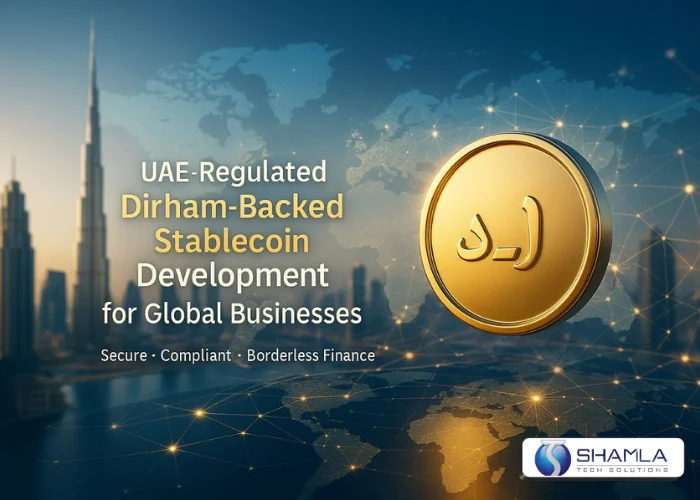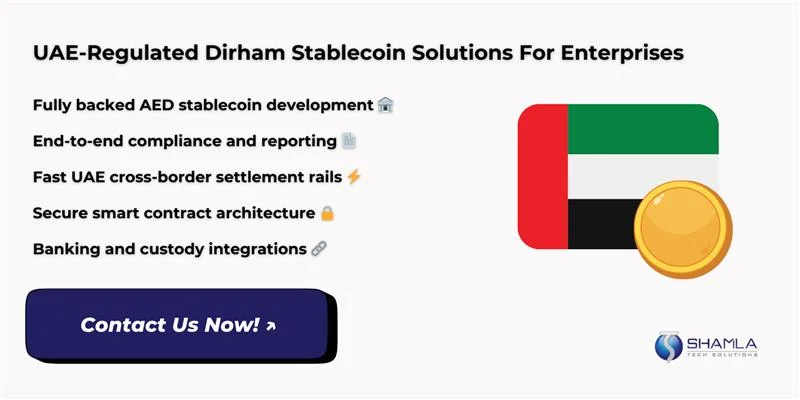The global adoption of digital assets continues to surge, and one of the strongest areas of growth is stablecoins backed by real-world currencies. Businesses increasingly prefer models that combine reliability with regulatory clarity, especially in regions with strong oversight. This is where Dirham-Backed Stablecoin Development stands out, offering a secure, compliant path for enterprises entering Web3.
With a clear framework under UAE stablecoin regulation, companies gain confidence while exploring modern financial tools. As demand for Fiat-Backed Stablecoins grows, new Stablecoin Use Cases are emerging across trade, remittances, and cross-border business operations.
The Rise of UAE-Regulated Stablecoins and Why Dirham-Backed Models Matter
Regulatory Certainty Drives Adoption
UAE regulators now give clear rules that make digital currency projects easier to trust. Dirham-Backed Stablecoin Development shows a direct path where issuers hold full cash reserves, publish proof of reserves, and follow simple reporting steps. That clarity reduces bank resistance and opens on and off ramps for business accounts.
Firms building AED-pegged stablecoin systems can plan partnerships with banks and auditors instead of guessing rules. For payment firms and traders, clear UAE stablecoin regulation lowers legal risk and speeds approvals, making it practical to integrate a dirham token into corporate treasury and banking services and clear operational checklists daily.
Simple And Secure Technical Design
Designs for a dirham token should be simple, safe, and easy to run. Dirham-Backed Stablecoin Development focuses on clear token rules: how tokens are created and destroyed, how price feeds update value, and how cash reserves are kept. Teams offering Stablecoin Smart Contract Development Services use tested code patterns, public checks, and simple upgrade paths so any auditor can review the system.
A Stablecoin Development Company must show its integration plans with payment rails, custody partners, and bank accounts to move from prototype to live use. Providers should also document recovery steps, capacity limits, and load testing results before launch.
Clear Compliance And Audit Trails
Good projects keep plain records so audits are fast and checks are routine. Dirham-Backed Stablecoin Development needs ongoing reserve reports, public token-supply logs, and easy reconciliation steps. These records help meet basic UAE blockchain compliance and show that the peg is kept. Clear, repeatable reporting reduces regulator questions and lets partners accept the token for payments and settlement.
Following simple rules for stablecoin operations prevents sudden policy issues and helps teams fix mismatches quickly without long delays or unnecessary downtime. Teams should set monthly audits, public dashboards, CSV exports, and simple dispute steps so partners can verify quickly and logs.
Fast Low Cost Cross Border Payments
Local-dirham tokens cut time and cost for moving money across borders. Stablecoins for Cross-Border Payments let firms settle trades and pay suppliers without waiting for slow bank rails. Properly built systems support instant settlement, lower fees, and Stablecoin Remittances, letting workers receive funds quickly in local accounts or wallets.
UAE Stablecoin Regulation that allows clear custody and bank links makes it easier for companies to route flows through Dubai and Abu Dhabi banking partners while keeping AML checks and currency controls in simple domestic view. These features speed commercial flows and reduce FX steps.
Why Do Businesses Prefer Trusted Providers?
Businesses pick vendors who show real banking links, simple code, and ongoing support. A development firm must explain custody, redemption flows, and clear public reserve statements before contracts start. Firms often hire teams for integration, testing, and live operations support, and they expect regular patching and monitoring.
Providers with simple, proven steps and a track record reduce rollout risk and speed adoption. Choosing a provider that uses clear processes, plain reporting, and rapid issue response keeps treasury teams confident and ensures steady operations for cross-border trade and payments. Ask for reference clients, case studies, integration guides, and 24/7 support.
Technical Architecture of AED-Pegged Stablecoins and Compliance Requirements in UAE
1. Core Token Model And Reserve Setup
Define a single-backed token with one-to-one cash backing and clear mint/burn rules. The reserve should sit in segregated bank accounts with scheduled proof exports and simple reconciliation steps. Dirham-Backed Stablecoin Development must set explicit float limits, redemption queues, and emergency pause controls to prevent run scenarios.
Keep token supply and reserve records public and machine readable so partners can verify peg status quickly. Use basic ledger reconciliation between on-chain supply and bank balances each day. Design simple redemption windows and clear dispute steps so operations teams can act without escalation.
2. Smart Contract And Oracle Design
Write short, well-tested contracts that manage minting, burning, and access control with easy upgrade paths. Use multi-sig and time-locks for admin functions and simple role checks to limit risk. Connect price oracles through signed feeds and fallback rules to avoid false peg triggers.
Dirham-Backed Stablecoin Development teams should add pause and circuit breakers for unusual activity and provide plain test suites for auditors. Keep gas and transaction limits reasonable and add on-chain monitoring hooks for basic alerts. Expose readable deployment artifacts and test results so banks and auditors can confirm behaviour.
3. Custody, Banking And On/Off Ramps
Choose regulated custodians and clear banking partners to hold fiat reserves and process flows. Build rails that support direct settlement between wallets and bank accounts and map every merchant and exchange connection. Offer Dirham-Backed Stablecoin services with KYCed merchant rails and defined settlement windows to limit settlement risk.
For AED-pegged stablecoin projects, ensure custodians can handle AED liquidity and local clearing. Keep withdrawal limits and fee rules explicit, and provide simple dispute and reconciliation channels for merchants. Document settlement timing, settlement finality, and fallback bank accounts to avoid failed settlements. Enable instant reconciliation for smoother operations.
4. Compliance, Reporting And Audit Workflow
Follow clear regulator rules and register where required before token issuance. Build simple reporting dashboards that show reserve balances, token supply, and recent redemptions to meet UAE stablecoin regulation expectations. Keep raw accounting exports, signed proof snapshots, and audit logs for independent review. Implement AML/KYC on issuance and redemption paths and automate suspicious activity alerts with clear escalation steps.
Maintain an incident playbook for peg breaks or reserve gaps and set communication templates for partners and regulators. Schedule routine reconciliations and CSV exports so auditors can re-run checks fast. UAE blockchain compliance should be visible in every report. Keep daily snapshots available.
5. Project Costs, Team And Deployment Plan
Estimate costs across legal, banking, custody, smart contract work, and ongoing ops. The Cost of Stablecoin Development must include third-party audits, oracle fees, bank setup, and compliance tooling. Hire Stablecoin Developers who know token standards, testing, and bank integrations.
Choose a Stablecoin Development Company for end-to-end delivery if internal hiring delays launch. Plan phased rollouts: sandbox for testing, pilot with limited partners, then national launch with rollback steps and load tests. Define SLAs, monitoring points, and patch plans. Track uptime, mismatch rate, and settlement time to measure success.
Why Global Enterprises Choose Shamla Tech for Dirham-Backed Stablecoin Services
Proven Banking And Custody Links
Shamla Tech holds direct banking and custody links that speed settlement and reduce risk. Clients using Dirham-Backed Stablecoin Development get clear paths to move funds between bank accounts and wallets. Our setup maps merchant flows, defines limits, and offers quick reconciliation tools so finance teams see exact balances. This approach supports cross-border payments in the UAE by cutting manual steps and lowering fees.
Shamla Tech runs proofs and offers bank-ready reports so partners accept tokens confidently and onboarding is faster. We provide 24/7 operational support, defined settlement windows, simple API hooks, and clear SLAs for every integration and live monitoring dashboards.
Simple Token Build And Issuance Kits
Shamla Tech engineers build simple token logic and clear minting rules. For Dirham-Backed Stablecoin Development we use tested templates, multi-sig controls, and plain oracle feeds. Our Dirham-Backed Stablecoin services include token issuance, compliance hooks, and custody links.
We design an AED-pegged stablecoin with direct bank settlement and fast redemption paths. Integration kits for wallets and merchants reduce error. For clients using cross-border payments in the UAE we add routing rules to handle local clearing and fees. We also document all flows, provide test sandboxes, and train client teams for smooth launch and steady operation and run routine live drills and checks.
Compliance First Operational Playbook
Shamla Tech builds clear compliance flows that match UAE blockchain compliance and regulator rules. For Dirham-Backed Stablecoin Development we map KYC, AML, reporting, and reserve proofs into the product. Our Dirham-Backed Stablecoin services include automated reporting, daily snapshots, and exportable audit files for authorities.
We align token operations with UAE stablecoin regulation to reduce stops and speed approvals. Teams can run audits, fetch signed reserve proofs, and reconcile on-chain supply with bank balances. This reduces manual audits and speeds merchant acceptance. We train client compliance teams and hand over simple playbooks for incident response and regulator queries and public dashboards.
Optimized Cross-Border Settlement Flows
Shamla Tech optimizes flow rules for cross-border payments in UAE so firms move money faster. Our routing logic splits settlement paths, chooses low-cost rails, and enforces fees and limits automatically. We provide direct payout paths to local banks and supported wallets, reducing conversion steps and FX costs.
For merchants and payroll use, we build instant payout options and batch settlement tools that match bank timings. Monitoring flags failed transfers and triggers retries or failover banks. Teams get clear reports and reconciliation files so accounting closes daily. This setup cuts settlement time, lowers costs, and reduces manual fixes and clear SLA.
End-to-End Delivery And Ongoing Support
Shamla Tech offers full project delivery from design to live operations. We run sandbox testing, staged pilots, and a measured rollout that limits exposure. Our engineers handle token code, oracle links, and bank connectors while the compliance team sets rules and reporting. Clients get a single vendor for building, testing, and ongoing support, cutting coordination overhead.
We also provide training, runbooks, and a simple incident line for fast fixes. Post-launch we track uptime, settlement time, and mismatch rates and deliver monthly health checks. This hands-on model helps enterprises deploy stablecoin projects with lower risk and clearer outcomes and client feedback.
Conclusion
The rise of regulated digital currency in the UAE gives global businesses a clear path to faster, safer financial operations. With solid rules, banks that understand digital assets, and strong demand for better settlement tools, companies now have real room to innovate.
Dirham-Backed Stablecoin Development helps firms build trusted payment systems, while Dirham-Backed Stablecoin services make day-to-day operations simple and dependable. As trade continues to expand, stablecoins will play a major role in streamlining cross-border payments in UAE, opening new doors for growth, efficiency, and global reach. Businesses that move early will gain the strongest advantages.
Contact us today to build your UAE-regulated Dirham-backed stablecoin!





